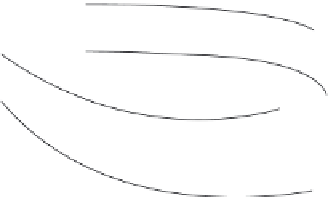Environmental Engineering Reference
In-Depth Information
The steady-state downstream concentrations are as
follows:
y
Y
x
x
c
(
x
, 0)
c
(
x
, 0)
water table
(m)
(kg/m
3
)
(mg/L)
plane source
Z
1
0.0094
9.4
10
0.0037
3.7
z
V
100
0.0012
1.2
ground water flow
1000
0.00039
0.39
plume boundary
Figure 5.8.
Dispersion from a continuous plane source.
5.3.3 Continuous Plane Source
The case where a conservative contaminant of concen-
tration
c
0
is continuously released from a plane source
of dimension
Y
×
Z
is illustrated in Figure 5.8. The
resulting concentration distribution,
c
(
x
,
y
,
z
,
t
), is given
by (Domenico and Robbins, 1985)
denominator of the error function of the
z
term is
replaced by
x
0
, prohibiting further spreading for
x
>
x
0
.
Domenico (1987) showed that for contaminants that
undergo first-order decay with a decay factor
λ
(T
−1
),
Equation (5.25) becomes
c
(
x Vt
Vt
−
)
=
0
c x y z t
( ,
,
, )
erfc
1 2
/
8
2
(
α
)
x
1 2
/
c
x
4
λα
(
y Y
+
/
2
)
−
(
y Y
x
−
/
2
)
=
0
x
c x y z t
( ,
,
, )
exp
1
−
1
+
erf
erf
(5.25)
8
2
α
V
1 2
/
1 2
/
2
(
α
x
)
2
(
α
)
x
y
y
1 2
/
x Vt
−
(
1 4
+
λα
/
V
)
(
z Z
+
)
(
z Z
x
−
)
−
x
erfc
erf
erf
2
(
α
Vt
)
1 2
/
1 2
/
1 2
/
2
(
α
x
)
2
(
α
)
x
z
z
(
y Y
x
+
/
2
)
−
(
y Y
x
−
/
2
)
erf
erf
where
V
is the mean seepage velocity (LT
−1
), and
α
x
,
α
y
,
and
α
z
are the dispersivities (L) in the
x
,
y
, and
z
coor-
dinate directions, respectively. The dispersivity in a
porous medium is defined as the dispersion coefficient
divided by the mean seepage velocity, where
2
(
α )
1 2
/
2
(
α
)
1 2
/
y
y
(
z Z
x
+
)
−
(
z Z
x
−
)
erf
erf
2
(
α
)
1
/
2
2
(
α
)
1 2
/
z
(5.28)
D
V
D
V
D
V
y
x
z
α
=
,
α
=
,
α
=
(5.26)
x
y
z
This solution assumes that the source concentration
remains constant at
c
0
. Both Equations (5.25) and
(5.28) are approximate solutions that have found wide
application in practice, and detailed discussion of the
limitations of these equations and suggested alternate
semi-analytic and numerical approaches can be found
in West et al. (2007), Srinivasan et al. (2007), and Batu
(2008). In some cases, such for radioactive wastes and
recalcitrant nonaqueous phase liquid (nAPL) spills, the
source concentration might also decay, and with a decay
rate that is different from the decay rate of the contami-
nant in solution (e.g., Williams and Tomasko, 2008).
and
D
x
,
D
y
, and
D
z
are the dispersion coefficients (L2T−1)
2
T
−1
)
in the
x
,
y
, and
z
directions, respectively. In Equation
(5.25),
x
is the longitudinal (flow) direction,
y
is the
horizontal-transverse direction, and
z
is the vertical-
transverse direction. If there is no spreading in the verti-
cal,
z
, direction, the error functions containing the
z
terms in Equation (5.25) are ignored and
c
0
/8 becomes
c
0
/4 (Domenico and Schwartz, 1990). The distance,
x
0
,
from the source to the location where the contaminant
plume is well mixed over the aquifer thickness,
H
, can
be estimated by (Domenico and Palciauskas, 1982)
EXAMPLE 5.4
(
H Z
−
)
2
x
=
(5.27)
0
α
A continuous contaminant source is 3 m wide × 2 m
deep and contains a contaminant at a concentration of
100 mg/L. The mean seepage velocity in the aquifer is
0.4 m/day, the aquifer is 7 m deep, and the longitudinal,
z
For distances of less than
x
0
, Equation (5.25) is appli-
cable; for distances greater than
x
0
, the distance
x
in the

































Search WWH ::

Custom Search